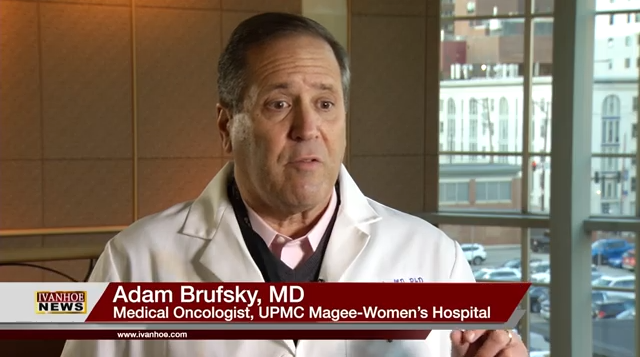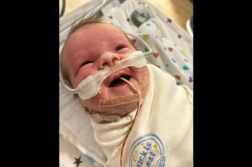Medical Oncologist at UPMC Magee-Women’s Hospital, Dr. Adam Brufsky, MD talks about a drug that helped one woman attend her son’s graduation that she thought she was never going to make.
Interview conducted by Ivanhoe Broadcast News in 2022.
I wanted to ask you about Enhertu. You heard a lot about this drug for women with metastatic breast cancer, right?
BRUFSKY: So it’s a class of drugs is when we call antibody-drug conjugates. And what that is, it’s an antibody against the HER2 protein, so it’s similar to a drug called Herceptin that’s been used for about 20 years. What we did, or what the investment that company did that developed this is actually put a little bit of chemotherapy on it. So it delivers a chemotherapy directly to the cancer cells that express HER2 anywhere in the body. And the idea is that theoretically, we can use less chemotherapy and so it’ll be less toxic but more effective.
Which women will this work the best for?
BRUFSKY: Well, initially we had it working for women who had HER2-positive breast cancer. That is a woman who had a lot of HER2 on their cancer cells, what we call three-plus, but it turns out the drug works really well with less HER2 on women’s cells as well. So HER2 1 plus HER2 plus. In fact, 85, or 70-80 percent of all women with metastatic breast cancer will likely be eligible to receive this drug.
How would you characterize it? Is this a game-changer?
BRUFSKY: It is. I think that the results we started seeing more than two years ago, international meetings have been confirmed. Even under the most recent national meeting, women who receive an HER2 as second-line therapy, their cancer does not progress for at least more than two years, 28.8 months. And they also have a benefit in terms of their survival. So it really has, and this is quadrupling the figures that we had before.
Metastatic breast cancer, even five years ago was a whole different thing, wasn’t it?
BRUFSKY: It was, I would go back even further than that. I think things like Herceptin, things like endocrine therapy for breast cancer, things like tamoxifen, Arimidex helped a bit, Herceptin helped a lot. But this is a drug really when it quadruples, what we call the progression-free survival, it really is a major advance in our field.
Can you talk to me a little bit about Tica?
BRUFSKY: Sure. So Tica is my long-time patient who has been with me for quite a long time. I believe about four years ago, began to develop disease recurrence in the wall of her chest. And we put her on a very effective drug, a drug called. The other name is in IBrands as well as anti-hormonal therapy. And she did really well. In fact, for scans up into about a year-and-a-half ago, was two years ago, look really good. And then she was actually visiting her son in school, and she came back and she said, boy, I just don’t feel well and my right side hurts and I did bloodwork on her. And her bilirubin which is a measure of her liver, was really high, meaning she was in liver failure. And we don’t really know what to do with her, we had some options. And I placed her on a very old drug called gemcitabine weekly because she wanted to try something and we did, not knowing what it’s going to work. And a week or two later, her friends called me and said, Dr. Brufsky, she’s doing much better. As possible, I said, wow, that’s great. And we had her come into clinic and her bilirubin, the test of how her liver was failing, it was actually down by half, so it was cut in half. So I kept giving her the drug. I kept giving her gemcitabine and her bilirubin back down to normal. And her disease and or liver went down dramatically. And we found during the- we decided to start looking at her cancer a little bit more closely because this happened. We were really excited that’s what she- and it turns out that she was positive for this HER2 protein on her cancer cells. And as a result, we sat around a series of therapies against HER2, the latest one being in HER2. And that’s done really well, she’s done extraordinarily well ever since it’s now- it’s now about almost two-year to year-and-a-half, which she has been doing really well.
Does she still have cancer?
BRUFSKY: She does. We’re never, unfortunately, we’re probably never going to make her cancer-free, but the idea is to get rid of as much of the cancer as we can and allow her to live as normal life as possible.
Metastatic breast cancer, is there going to be a time in your mind where this is more of a chronic disease treating it chronically?
BRUFSKY: I think we’re getting there now. So the idea behind metastatic breast cancer is not something that you can live with, hopefully, as little intervention as we can do. And in HER2-positive breast cancer like Tika has, I think that if you can get rid of all the cancer, you have what’s called a clinical complete response, people do very well for a very long period of time. And I think that’s even with SRAM separate positive metastatic breast cancer, a little bit different than what she had. People can live many years now, and so our goal is to turn into something chronic. I think the latest thing is that we’re working to try to figure out what happens to women now who do really well is I think that relapse in their brain because a lot of the therapies we have don’t get into the brain. And so that’s an area of intensive research that we’re doing right now to try to figure out how to treat cancer that’s gone into the brain, metastatic breast cancer. It’s very similar to what happened with leukemia in kids, pediatric leukemias. I think when they started using multiple- multiple drugs together for pediatric leukemias is probably in the late ’70s. Suddenly the cure rate went from a 20-30 percent or long-term survival room 20-30 percent up to about probably 70-80 percent. And what’s really drove it even higher than that, upwards of 90 percent was that the leukemia doctors of the time, and now this is over 40 years ago, realized that they had to get therapy into what’s called the sanctuary of sites. And one of that- one of those sites is the brain. And we figured out how leukemia into the brain to kids who have pediatric leukemias are suddenly the survival and above 90. Well, I think it is about 90 percent or above now, for most of them. And so we’re going to try to do the same thing in metastatic breast cancer. In my business, and I’ve been doing this a long time over a quarter century. I think we really are turning it from something that was an acute crisis. And it can be an acute crisis, but people- it’s cancer, it can get worse and get better, but what we’re really trying to do in all the three major forms of metastatic breast cancer. As receptor-positive, which is sensitive to estrogen, HER2-positive which sense for things like Herceptin and other drugs, and triple-negative, which is neither. What we’re trying to do is really turned into something where we can treat it acutely, get rid of a lot of it, and then maintain somebody on somebody- on- on another sort of therapy for an extended period of time. In other words, turning into a chronic disease. And I think in my lifetime of doing this for over a quarter century, we’re getting there. We’re actually getting close to it.
Enhertu is adminstered every three weeks, right?
BRUFSKY: Yes.
Of infusion?
BRUFSKY: Enhertu which is given every three weeks as an intravenous infusion. Yes.
How long can you take this time a month?
BRUFSKY: We’ve had people on it for over 2-3 years until it stops working. There- there are a few side effects, so there’s a unique side effect. About 10 percent of people get an inflammation of the lungs called interstitial lung disease, so you should be careful about that. But short of that is something people could take for an extended period of time.
What is ADC?
BRUFSKY: ADC are antibody-drug conjugates, that’s what it is.
What is Enhertu?
BRUFSKY: Enhertu is a classic antibody-drug conjugate. There’s another one that we use called Kadcyla which is a little bit different.
And what’s the promise of this?
BRUFSKY: They’re tremendous. Literally and HER2 has changed the way we treat breast cancer. And in fact, the fact that we- only about 20 percent of women have HER2-positive- have HER2-positive breast cancer, there’s another 70- well, another 50-65- 50-60 percent of women, so a total of 75 percent of women now, even those that are not HER2-positive are eligible to receive kit of this in HER2 drug, I think it really has changed everything.
END OF INTERVIEW
This information is intended for additional research purposes only. It is not to be used as a prescription or advice from Ivanhoe Broadcast News, Inc. or any medical professional interviewed. Ivanhoe Broadcast News, Inc. assumes no responsibility for the depth or accuracy of physician statements. Procedures or medicines apply to different people and medical factors; always consult your physician on medical matters.
If you would like more information, please contact:
Cyndy Patton
(412) 415-6085
Sign up for a free weekly e-mail on Medical Breakthroughs called First to Know by clicking here




